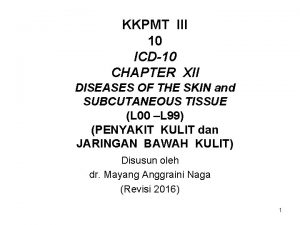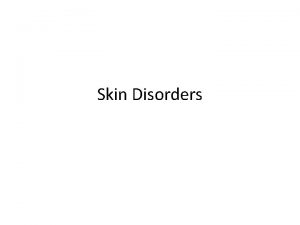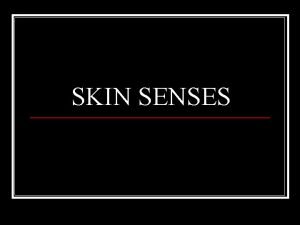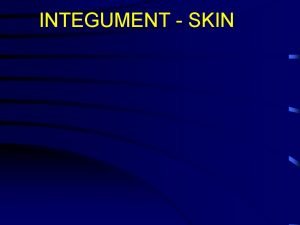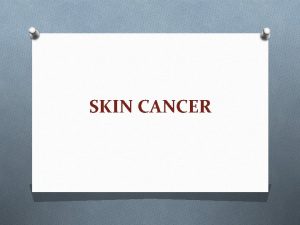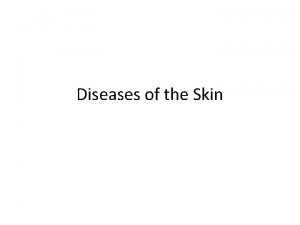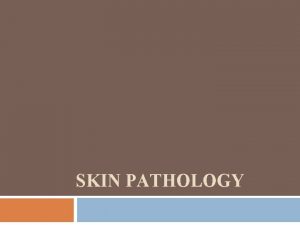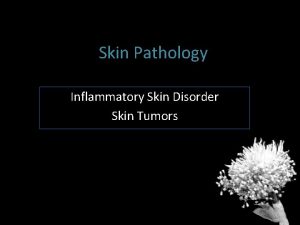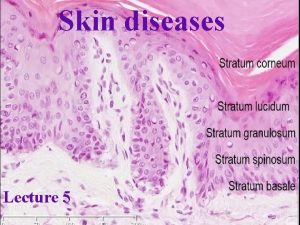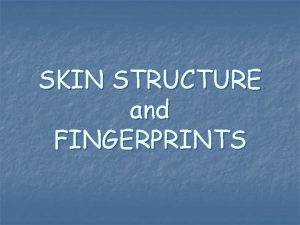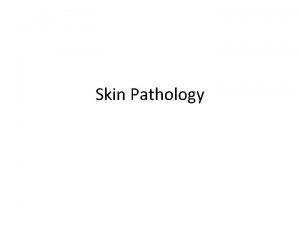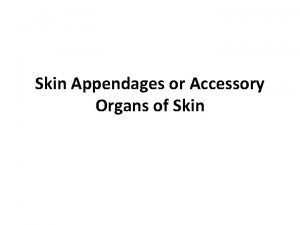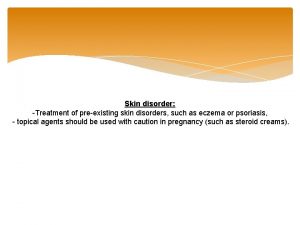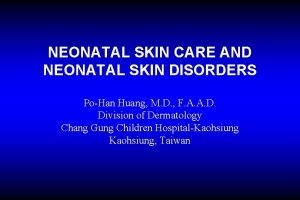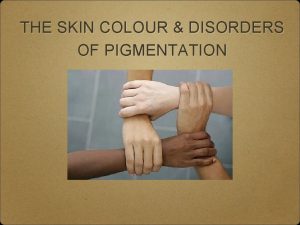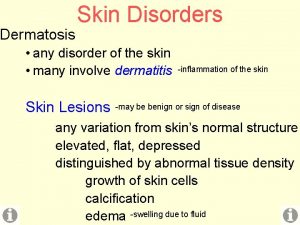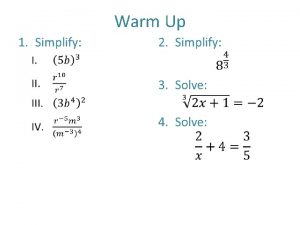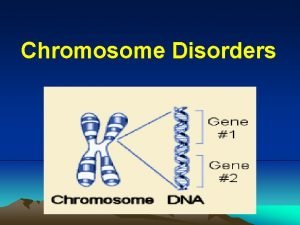Disorders of the Skin Warm up 1 2






























- Slides: 30

Disorders of the Skin

Warm up 1. 2. 3. 4. 5. 6. What is the muscle attached to the hair that makes the skin pucker and the hair stand erect? Receptors for touch, cold and pain present in the skin are responsible for which function of the integumentary system? The evaporation of perspiration enables which function of the integumentary system? Using a nitroglycerin patch is an example of which integumentary function? Sudoriferous glands produce and odor when their secretion mixes with what? The skin is the bodies first line of defense. What function of the integumentary system is this?

ACNE § Sebaceous glands produce increased amount of sebum during adolescence causing acne. § Common/chronic disorder of the sebaceous glands § Sebum plugs pores and then area fills with leukocytes § Blackheads, cysts, pimples and scarring


Athlete’s Foot § Contagious fungal infection § Usually contracted in public baths and showers § Rx – antifungal agents § Prevention is by practicing good personal hygiene and not sharing towels in the locker room.

Dermatitis § Non-specific inflammation of skin § Can be a rash – reaction to soap, plants, allergens, frequent handwashing and exposure to chemicals. § Can be emotional – stress can cause skin blotches

Genital Herpes § § § Viral sexually transmitted infection Blister in genital area Spread through sexual contact Periods of remission and exacerbation Rx- Acyclovir Can be passed to newborn during vaginal delivery


Skin Cancer § § § Caused by exposure to direct sun Most common type of cancer in people Malignant Melanoma § Occurs in melanocytes § Metastasizes to other areas quickly § Appears as brown or black irregular patch that occurs suddenly § A change in an existing wart or mole may indicate melanoma § Rx – surgical removal of melanoma and surrounding area and chemotherapy



Albinism § Absence (or decreased amount of melanin in the skin) A person with albinism will have one of the following symptoms: § Absence of color in the hair, skin, or iris of the eye § Lighter than normal skin and hair § Patchy, missing skin color Many forms of albinism are associated with the following symptoms: § Crossed eyes (strabismus) § Light sensitivity (photophobia) § Rapid eye movements (nystagmus) § Vision problems, or functional blindness


Alopecia (baldness) § § § § Autoimmune reactions Related to medications Stress Hypothyroidism Genetic Environmental exposures Chemotherapy or radiation treatment May be patchy or widespread

Alopecia in treament…

Warts- viral § Type of HPV that infects the top layer of the skin. § 5 types- plantar, common, flat, filiform, periungal § Can be removed but most often will recur

Burns § Caused by radiation, sun, boiling water, chemicals, fire or electricity § Rule of Nines – measures percent of body burned. Body divided into 11 areas, each is 9% of body surface § Treatment:

Burns

First Degree Burns § § § Involves only the epidermis Sunburn is an example Symptoms: redness, pain, and small amount of swelling Treatment – apply cool water and analgesics for pain Healing Time: 3 – 6 days and tissue destructions is minimal

Second Degree Burns § May involve the epidermis and the dermis § Symptoms: Pain, swelling, redness and blisters (Skin may be exposed to infection) § Treatment: Pain medication and dry sterile dressing over open skin areas (DO NOT POP THE BLISTERS!) § Healing Time – 2 -3 weeks with minimal cosmetic defects ( May have change in skin color or pigmentation)

Another 2 nd Degree Burn

Third Degree Burns § Destruction of the epidermis, dermis and sometimes the subcutaneous layer § Can involve underlying muscles and even bones § Symptoms: loss of skin, muscle and bone- eschar § There may be no pain due to damaged nerves § May be life- threatening damage depending on the amount of skin and fluid loss, as well as plasma § Treatment: § Immediate hospitalization § Prevent infection and skin contractures § Fluid replacement § Skin grafts as soon as possible


Third Degree Burns § Third degree burns destroy the whole skin layer, including underlying fatty tissue. If more than 10% of the body surface is affected the victim will be in a state of physiological shock immediately after the accident, due to loss of body fluids from the burned area. This can be fatal if not treated by intravenous fluid replacement. Loss of skin exposes the body to contamination by bacteria, which may cause fatal complications. For this reason the victim is treated by isolation nursing in a specialist burns unit. Skin grafts are eventually required.

Burns

Rule of Nines § Treatment and possibility of recovery from burns depend on the total body area affected and the severity of the burn § It is used to measure the percent of the body burned.

Rule of Nines § The body is divided into 11 areas and each area accounts for 9% of the total body surface § Major Burns: § Second degree over 25% of adult body surface area (b. s. a. ) or more than 20% of a child’s body surface area § Third degree burn over more than 10% of adult body surface area.

§ Patrick was involved in a fire when his race car crashed. He burned his face, entire right arm, back of right leg, and front of right leg. What percent of his body was burned?


Processing § What type of burn involves the complete destruction of the epidermis, dermis and the subcutaneous layer? § What skin condition is also classified as a viral sexually transmitted disease? § What is the primary cause for skin cancer? § What does a Malignant Melanoma lesion look like? § Sebaceous glands produce increased sebum as a teenager. What condition does this cause? § What do the sebaceous cells fill with when they get plugged? § What skin condition is caused by contact with an allergen or frequent handwashing? § What viral skin lesion can recur after removal? § What fungal disorder can be prevented by practicing good personal hygiene, not sharing towels and wearing shower shoes in the locker room?
 Disorder of skin and subcutaneous tissue adalah
Disorder of skin and subcutaneous tissue adalah Chapter 8 skin disorders and diseases
Chapter 8 skin disorders and diseases Contoh soal kkpmt
Contoh soal kkpmt Define a primary skin lesion and list three types
Define a primary skin lesion and list three types Milady chapter 8 skin disorders and diseases
Milady chapter 8 skin disorders and diseases Skin information
Skin information Thin skin vs thick skin
Thin skin vs thick skin Milady chapter 23
Milady chapter 23 ưu thế lai là gì
ưu thế lai là gì Hệ hô hấp
Hệ hô hấp Tư thế ngồi viết
Tư thế ngồi viết đặc điểm cơ thể của người tối cổ
đặc điểm cơ thể của người tối cổ Cái miệng nó xinh thế
Cái miệng nó xinh thế Hát kết hợp bộ gõ cơ thể
Hát kết hợp bộ gõ cơ thể Mật thư anh em như thể tay chân
Mật thư anh em như thể tay chân Tư thế ngồi viết
Tư thế ngồi viết Chó sói
Chó sói Thẻ vin
Thẻ vin Thơ thất ngôn tứ tuyệt đường luật
Thơ thất ngôn tứ tuyệt đường luật Các châu lục và đại dương trên thế giới
Các châu lục và đại dương trên thế giới Từ ngữ thể hiện lòng nhân hậu
Từ ngữ thể hiện lòng nhân hậu Diễn thế sinh thái là
Diễn thế sinh thái là Slidetodoc
Slidetodoc V cc cc
V cc cc Vẽ hình chiếu vuông góc của vật thể sau
Vẽ hình chiếu vuông góc của vật thể sau Phép trừ bù
Phép trừ bù Sự nuôi và dạy con của hổ
Sự nuôi và dạy con của hổ Lời thề hippocrates
Lời thề hippocrates Chụp phim tư thế worms-breton
Chụp phim tư thế worms-breton đại từ thay thế
đại từ thay thế Quá trình desamine hóa có thể tạo ra
Quá trình desamine hóa có thể tạo ra
